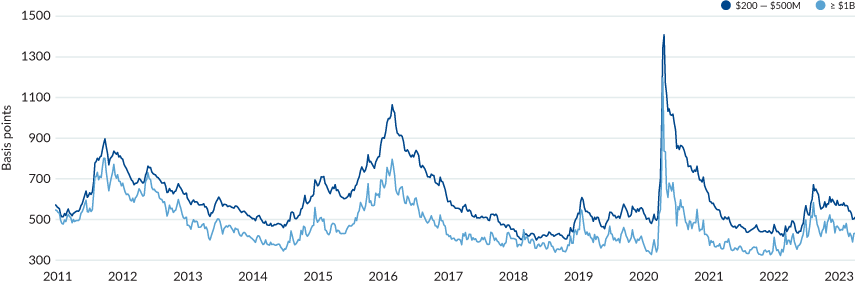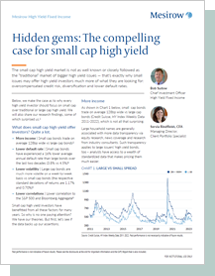Insights
Hidden gems: The compelling case for small cap high yield
Share this article
The small cap high yield market is not as well known or closely followed as the “traditional” market of bigger high yield issues — that’s exactly why small issues may offer high yield investors much more of what they are looking for: overcompensated credit risk, diversification and lower default rates.
Below, we make the case as to why every high yield investor should focus on small cap over traditional or large cap high yield. We will also share our research findings, some of which surprised us.1
What does small cap high yield offer investors? Quite a lot.
- More income | Small cap bonds trade on average 128bp wide vs large cap bonds2
- Lower default rate | Small cap bonds have experienced a 16% lower average annual default rate than large bonds over the last two decades (3.8% vs 4.5%)3
- Lower volatility | Large cap bonds are much more volatile on a week-to-week basis vs small cap bonds (the respective standard deviations of returns are 1.17% and 0.70%)4
- Lower correlations | Lower correlation to the S&P 500 and Bloomberg Aggregate5
Small cap high yield investors have benefitted from all these factors for many years. So why is no one paying attention? We have our theories. But first, let’s see if the data backs up our assertions.
More income
As shown in Chart 1 below, small cap bonds trade on average 128bp wide vs large cap bonds (Credit Suisse, HY Index Weekly Data 2011-2022), which is not all that surprising.
Large vs Small Spread

Source: Credit Suisse, HY Index Weekly Data 2011-2022. Past performance is not necessarily indicative of future results.
Large household names are generally associated with more data transparency via equity research, news coverage and research from industry consultants. Such transparency applies to large issuers’ high yield bonds, too — analysts have access to a wealth of standardized data that makes pricing them much easier.
Conversely, a small issuer from a small industry will be much less known, and reliable data will by harder to come by. An analyst must do a lot more work to form an estimate of value and may lack confidence in that estimate once it has been made. When investors are not confident of their valuations, they rationally build in an extra margin of safety or an extra margin of yield.

1. Throughout this paper, we use the size of the bond issue as a generally accurate proxy for the size of the issuing firm. This is commonly done because firm size, measured by sales, profits, or market capitalization, is dynamic what is a small firm one year may become a mid-size firm in the near future. And the market capitalization of private companies cannot be observed. Issue sizes, on the other hand, remain constant, so averages across long periods have meaning. | 2. Credit Suisse HY Index Weekly Data 2011-2022. | 3. JPM, Bloomberg 1999-2021. | 4. Credit Suisse HY Index Weekly Data 2011-2022. | 5. BAML, Bloomberg, eVestment 1994-2022.
Spark
Our quarterly email featuring insights on markets, sectors and investing in what matters
